Did We Land on the Moon?
Following the first transmission of the FOX TV documentary Did We Land On The Moon? in the US, NASA has pointed interested parties towards certain web pages. It would seem that some of these sites have elected to defend the honour of this government agency. In so doing, explanations posted on these sites have addressed – to their apparent satisfaction – some of the points raised by those who question the veracity of the Apollo record. However, a number of these explanations require yet further responses.
NASA protests that it is accused of being incapable of sending men to the Moon in the 1960s (they certainly were not able to do so in the 1990s) and therefore the agency must have faked Apollo.
Yes, many of NASA’s accusers are indeed saying just that.
However, Bennett and Percy have always stated that man may well have travelled to the Moon in 1969 but maintain that the Apollo imagery is not the true and accurate portrayal of such an event. As a result of the interviews they have conducted with those involved in the Apollo program it became very clear to them that there were numerous discrepancies between the information presented to the public, and the facts as known to some NASA contractors.
These issues were to join the photographic and TV anomalies as worthy of examination. So a book that started out as an investigation into the photographic and film record became, of necessity, a much deeper look into the events before, during and after Project Apollo.
While the Aulis video production What happened on the Moon? sets out some of the problems inherent in the presentation of NASA’s record of Apollo, only their book Dark Moon: Apollo and the Whistle-Blowers covers the deeper implications and issues of this subject. All the objections as to why it might have been impossible to keep such a ‘secret’ have also been addressed in detail by these two authors. While most of the questions sent to Aulis Online find their answers within the pages of this book it is clear that many of the critics of Bennett and Percy’s Apollo hoaxed record theory have either taken badly timed coffee breaks whilst watching What happened on the Moon? or have not read Dark Moon at all.
Some answers to questions that Aulis has received as a result of the FOX TV documentary:
When David Percy was talking to a cryogenics expert, who worked for Grumman Aerospace (the NASA contractor that built the Lunar Module) this highly respected engineer stated that there were inconsistencies in the appearance of the rocket exhausts from the LM’s engines as depicted in the Apollo film and TV coverage.
No, that is not right. There are, without doubt, serious discrepancies in shadow lengths and the direction of shadows cast by astronauts as well as objects (such as rocks). Take for example these images from Apollo 11:

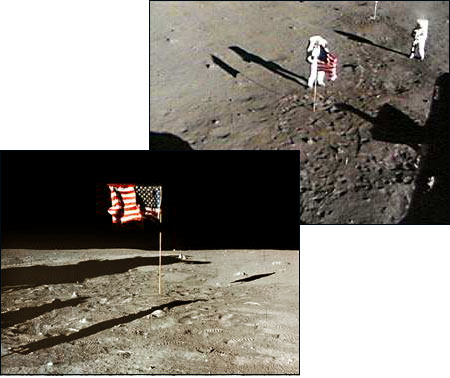
The two Apollo 11 astronauts – (upper photos) captured by the Data Acquisition Camera (DAC) mounted high on the LM – each have very different shadow lengths. The lower photo shows that essentially the terrain is flat, therefore the lack of variation in surface height cannot be a valid reason for any shadow to vary in length.
These shadow lengths increase and decrease as the astronauts move about in the area covered by the DAC. An explanation for this anomaly is that the two men are standing in such close proximity to a large artificial light source that as either one moves nearer to or further away from this light, the shadow of each astronaut changes accordingly – we have demonstrated this effect in What happened on the Moon?
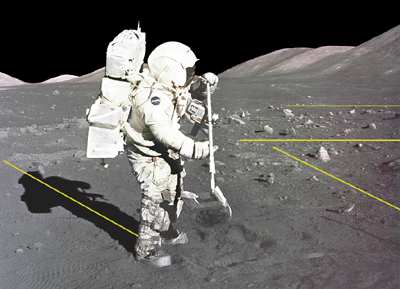
Schmitt on the Apollo 17 lunar surface
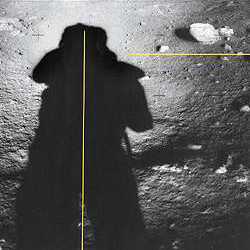 Apollo 17 astronaut shadow |
An example of converging shadows is to be found in the Apollo 17 record (picture above), in this instance Schmitt is raking what purports to be the lunar surface.
Look at his diagonal shadow of Schmitt on the left of the frame, and compare it with the totally different horizontal shadows cast by the rocks on the upper right. Then notice the diagonal shadow cast by the rock middle right.
Another photo from Apollo 17 of a prominent astronaut's shadow virtually fills the frame where the shadow of the photographer astronaut and the shadow of the rock (at the upper right of the image) are virtually at right angles to one another.
True whistle-blowing in action.
Then notice that all the shadows from each item in the sunlit scene (photo below) fall to the right of the image, irrespective of the relative height or shape of each object.
Typical scene lit by natural sunlight |
When the entirety of an photograph is illuminated by the parallel rays of the Sun horizontally across a scene (rather than from an artificial light source).
The objects in the distance as well as the objects in the foreground cast their shadows in the same direction, horizontally across the entire image.
Now compare this result with a photograph from Apollo 14 below. This image is typical of the result one would expect if the light for the scene is not from the Sun, but is emanating from an artificial light source generating a beam that spreads out from its relatively close position, thereby producing non-parallel shadows.

AS 14-68-9486+7
Virtually all the rocks in this scene (some are scattered singly on the terrain, some are grouped on a low mound) cast their shadows diagonally towards the right-hand corner of the picture, not horizontally to the right, as is the case with the shadow of the LM in the distance.
On close examination the rocks themselves appear to be illuminated by a light source that is positioned more three-quarters to the rear, than side-on to the object, as indicated by the diagonal yellow line. This photograph is worth studying carefully. For more on this image, and the area contained in the white rectangle, please see Apollo anomalies and inconsistencies.
In the still imagery as well as in the ‘live’ TV coverage there are numerous instances where any given placing of the LM can have a variety of ‘interchangeable’ mountain backgrounds. For example Michael DeWoody has made some excellent comparisons between different Apollo pictures. Take for example the Apollo 15 mission.

Perspective view backdrop AS15-88-11863

Front view backdrop AS15-88-11865
The position of the astronaut, the flag, and the LM are virtually the same in these two photographs – the lateral displacement between the two camera positions is minimal. However, in the first picture the mountain background is a perspective view (at an angle to the photographer) whereas the mountain in the second photo is square on to the camera.
It is important to bear in mind that the distant mountain is supposed to be over 13,000 feet high and more than four miles away. Therefore a camera located a few feet either to the left or right would make no practical difference to the perspective of the mountain.

Combination of the two images AS15-88-11863+11865
This is a combination of these two photos. Notice how the two mountain backdrops differ considerably in height – by as much as 20% – whilst the sizes of the other key elements of the scene remain essentially the same. In our view such a result is the consequence of the mountain backdrop having been physically replaced with an alternative backdrop scene.

Side view of mountain backdrop and studio floor
The above is an illustration of how a moveable mountain backdrop would appear in a studio set when viewed from the side – the flat area in front representing the studio floor.
Alternatively, these pictures could be composites, having been assembled in the lab by the traditional photographic ‘cut and paste’ method. If you look carefully at the perspective view backdrop (AS15-88-11863 above), you can see a lighter zone in the black area where the mountain might otherwise have continued – as if it had been airbrushed out – leaving a tell-tale indication of a touching up process. As the same backgrounds were needed for both TV and still photography, we tend to favour the SSS solution: the ‘shifting scenery scenario’. However, in either case, the inconsistencies in the continuity of these images cannot be an accident. In our opinion this example is good evidence of intentional whistle-blowing.
No. It was actually ordinary Ektachrome film emulsion on a polyester base. However, it is now claimed by the Enterprise Mission (post justification?) that there was a special transparency film created for these missions under a NASA contract. Called XRC, apparently this was a “specially extended range color slide film” that “allowed the astronauts to take perfect National Geographic-quality pictures”. So you might ask how does the agency justify the fact that – according to Kodak in 1969 and confirmed again in 1996 – the film was just ordinary 160 ASA high speed Ektachrome?
The XRC film’s light-gathering abilities were apparently “quite amazing” according to recent claims. It is not clear if this description is supposed to refer to the film’s speed rating or its exposure latitude, because even today, Kodak’s current professional slide film Ektachrome E200 still requires the correct exposure for any given set of lighting conditions.
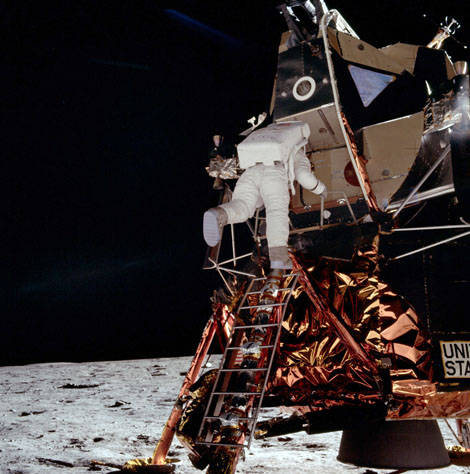
AS11-40-5866 Example of additional lighting to illuminate the side of the LM in total shadow
In 1969, using 160 ASA Ektachrome, one could not expect to have the entire image correctly exposed in a scene that contained both a range of very dark, virtually black, subjects and terrain lit by full sunlight – as with Aldrin descending the ladder above. Especially if the photographer was using reversal film and did not have an automatic camera! Even with the aid of a light meter, and the possibility of checking with a Polaroid shot first (which professional photographers usually do today, but an aid that was not available to the Apollo astronauts) it would have been impossible to achieve such results without artificial lighting to bring up the subject in the dark part of the frame.
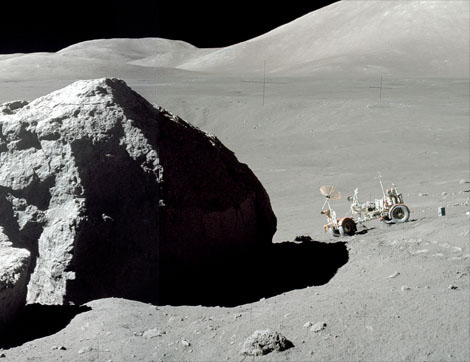
AS17-140-21494+7 Total blackness on the shadow side of a rock (without additional lighting)
A glance a the picture above shows exactly what we mean by the absolute blackness that manifests on the shadow side of an object or rock – even if such an image really was taken on the Moon. Any Earth-shine and/or reflection from the lunar surface has no effect whatsoever on the shadows in the scene.
It is true, that compared with the 1960s, present day films have greatly advanced properties. Reversal film (which is what we are discussing as pertinent to the Apollo missions) by its very nature cannot deliver the same latitude available in colour negative emulsions. The demonstration of this fact is manifest in Kodak’s exposure guide for Ektachrome E200 (reversal transparency/slide) film. From which we can deduce that any extended exposure latitude claimed for this super-lunar reversal XRC film does not appear to have reached the professional market for reversal or transparency/slide films. Our enquiries have revealed that Hasselblad, the makers of the Lunar Surface Camera are not officially aware of any extended range colour film that may have been produced for Apollo.
For an image taken with a reversal film to render a satisfactory high quality transparency it has to be exposed correctly in the first place. Reversal films have a tolerance of about one stop. In the case of a subject encompassing both total shade and sunlit terrain, when selecting say an average exposure with reversal film, any dark areas would reveal no detail and the bright areas would be totally over-exposed.
Imagine photographing someone just inside a cave at a time of day when the Sun is not shining into the cave. You, the photographer, are standing inside looking out of the cave. The challenge would be to obtain – without a flash – a good exposure between the person in the darkness of the cave and the relatively bright sunlit terrain beyond. In other words, a capability of covering at least f/5.6 to f/22, a range of at least four stops. Even today it would be difficult to get a satisfactory result on reversal film without extra lighting in the cave to balance the extremes.
Many of us must remember those rather dark and gloomy-looking images on TV when Armstrong stepped out of the LM in 1969. But the still photographs of Aldrin descending the ladder are bright, clear and of studio quality, despite the setting being in the total pitch black shadow of the LM. Why such a difference between the stills and the TV you may ask? Particularly when the TV camera was equipped with a special night lens for use under such situations. Well, no lighting was used for the TV. Result – very dark TV pictures. But the subject in the still photographs could easily have benefited from the use of flash.
See again Aldrin descending the ladder of the LM – in total shadow.
The fact is that there are many scenes like this one in the Apollo record. This strongly suggests the use of artificial lighting. But there is one major problem. No such lighting was taken to the Moon.
It was HJP (“Douglas”) Arnold, who was the Assistant to the Managing Director of Kodak Ltd. He was also the representative Kodak appointed to answer our questions back in 1997. Arnold clearly stated that essentially the film used for the lunar photography was ordinary high speed Ektachrome emulsion, 160 ASA (as it was then), on a thin base.
You might ask: “was HJP Arnold misinformed?” Because if his recollection is correct, then the claimants for the use on the Moon of this special XRC film must surely be incorrect. But if this XRC film was used on the Moon without the knowledge of those at Kodak charged with the promotion of Apollo in the UK, as HJP Arnold was, then he must have been given erroneous information. And in turn the public must have been unwittingly misinformed through Kodak’s publicity machine.
That situation could well be the case. If R C Hoagland was in possession of this XRC film and, as he states, used many rolls of it while advising Walter Cronkite then by his own admission RCH could be involved in a secret withheld from those within the program as well as the public. If this were so, whatever the reasons (military or otherwise) for such an undertaking, in our view, RCH is in no position to maintain the moral high ground over those who query the validity of the official Apollo record.
All the images, even the ‘less good’ or ‘more ordinary’ pictures, exhibit the same contradictory errors – or deliberate mistakes.
In fact the Hasselblad still cameras were silver in colour, not white and the astronauts apparently could not rely on the fact that they were just wearing white fabric suits as protection because temperature regulation was provided via a series of water tubes inside their suits. This provision was considered essential. In any event, whether white or silver, these suits would have offered no protection at all against SPEs or solar flares.
This subject of radiation dangers is dealt with in great detail in Dark Moon. Depending on the source consulted there are different widths and danger zones attributed to the Van Allen radiation belts, which become as elastic as the needs of the moment require. Even today NASA’s defenders are quoting different figures for these belts, all of them much slimmer than those set out by Dr. James van Allen.
The nub of the matter is this: by stating that the depth of these belts is many thousands of miles less extensive than they really are, the ability to travel through them in a short period of time is maintained, and thus the astronauts have been ostensibly protected from harm.
According to an expert at DERA in the UK: “Radiation is the biggest show stopper affecting mankind’s exploration of the universe.” As far as the probability of encountering SPEs or solar flares went, the thin-walled Apollo craft (from 8 through to 12) travelled during a solar maximum period, a time when there was a likelyhood of three or four severe flares per mission. The ability to predict solar flare activity was, and still is, very poor indeed. The CSM did not have any shielding against such an event. Neither did the LMs, nor did the spacesuits.
If you were responsible for the continuance of funding of your agency, would you have risked your very public astronauts being fried, live on screen, to the sound of music? For this very reason alone we maintain that surrogates would have been a necessity to cover for the named astronauts.
If it was known that an Apollo astronaut had died, whenever anyone looks at the Moon they would be reminded of a dead American astronaut up there on the lunar surface.
What now Houston?
A very good point. The official Apollo record had variations on ‘dust/no dust’ with some of the astronauts claiming there was very little dust – hardly any dust at all. And the argument for different conditions at different locations is rather difficult to sustain, as there were no massive “swirls of dust” visible in any of the ‘live’ TV coverage of LM take offs. What we did see was a bright burst as the Mylar covering breaks apart at lift-off (see below – an Apollo 14 image). Yet apparently on Apollo 11 there was enough dust to permanently clog up the laser reflector – placed some 40 feet (distance from LM dependant on the information source) from the take off position.
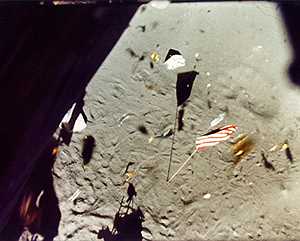
No swirls of dust visible at take off
A Grumman engineer who worked on the Lunar Module informed us: “It was absolutely necessary to be able to see the surface to land the LM.” If there were clouds of dust as stated, (to say nothing of billowing dense exhaust gases from the engine burning hypergolic fuels) there would have been no way of seeing the ground beneath the craft during the latter phase of the critical landing procedure. So one of our critics who writes:
“ ...in each and every case ... the LM groped its way down, balanced on its 3,000lb thrust engine” may be writing poetically, but certainly not accurately. And while we are on the subject, according to the published data, the LM had a descent engine capable of delivering not just 3,000lbs but over 10,000lbs of thrust. Given that weight was an issue, and every component was stripped to the minimum, then clearly the descent engine had a requirement for that amount of thrust to safely accomplish the task. Why is there a need to minimise the amount of thrust? It could be to avoid these issues of heat and dust.
There are those who can see ‘cover-up’ written all over NASA’s PR take on Mars, but still promote its honest accounting of Apollo! We would suggest that you consider all the new evidence presented in Dark Moon and then decide for yourself, but remember that old saying ‘A leopard does not change its spots’.
The possibility that there might be ‘structures’ on the Moon visible in the black areas of the photographs could have a very simple explanation: If the photographic record is shown to be faked, then anything visible through the black upper areas of the images could be evidence of constructional supports behind the simulated mountain backdrops in an Earth-bound studio. Obviously, anyone wishing to actively promote the idea of ‘alien structures on the Moon’ would not welcome the proposition that the Apollo images may be faked by human beings. Why this hypothesis of Alien bases may require to be promoted would take too long to go into here, but is addressed in Dark Moon.
If that were truly the case, NASA would have to present (albeit via its surrogate representatives) rather more cogent arguments than those expressed thus far. Indeed the agency is doing a very good job of not adequately answering questions.
As of 18 April 2001 the NASA site Project Apollo Archive had a section recommended by NASA as being “excellent document and web sites” relating to the Apollo hoax theory. One of these was a site of FAQs—and interestingly section 6 titled ‘conclusive evidence Apollo was real’ – has no answers at all! Stating only ‘not yet complete’ under each heading. The site was last modified on 17 February 2001. The Apollo Project took place over thirty years ago – how long does it take to check the details?
Clicking on the last of their ‘excellent document and web sites’ reveals another listing of four sites that comes with a health warning, part of which we reproduce here: “. . . These individuals in most cases had no link to NASA . . . Keep in mind that since these are not NASA or government sites, the tone of the remarks and information is not what one would see on a NASA page. They are, however, independent sources.”
Noting that ‘in most cases’ means ‘some, but not all’, the word independent surely does not apply to all of them. So a question you might ask is: how many of their four recommended sites are actually linked to either NASA or a government?
Indeed, some of these particular defenders of the faith have, on occasions, resorted to exaggeration, personal abuse and inexactitudes (and in the face of the evidence been obliged to apologise and back down). If any ‘conspiracy theorist’ responded to NASA in such a manner they would be accused of being non-scientific, lacking in common sense and summarily dismissed.
Perhaps the Mars researchers at NASA do not recall the imagery of the lunar EVAs (unlikely). Supposing, charitably, that the ambling or gambolling lunar walk was decided upon in ignorance, then one might suppose that if the Apollo astronauts had truly walked on the lunar surface they would have immediately discovered that moving fast was much more comfortable and energy efficient – and adjusted their movements accordingly. So once again, new NASA data has supplied researchers with information that suggests that the named Apollo astronauts did not walk on any real lunar surface.
Bennett and Percy never expected a mea culpa from the authorities concerning Apollo. Just like their most vociferous critics, they too wish that in the future mankind goes forward into space in truth and honesty. The general public should be participants in this experience through the reception of truthful information honestly brokered – not pre-packaged ‘live’ TV coverage, denial and cover-up.
Those currently running the space program cannot set right any errors of judgement made during those Apollo days. But they can choose not to repeat such errors. For all our sakes the authors of Dark Moon hope that these individuals will heed their own whistle-blowers.
Sadly, to date there is no sign of such a rectification.
Aulis Online, 2001
AULIS Online – Different Thinking
